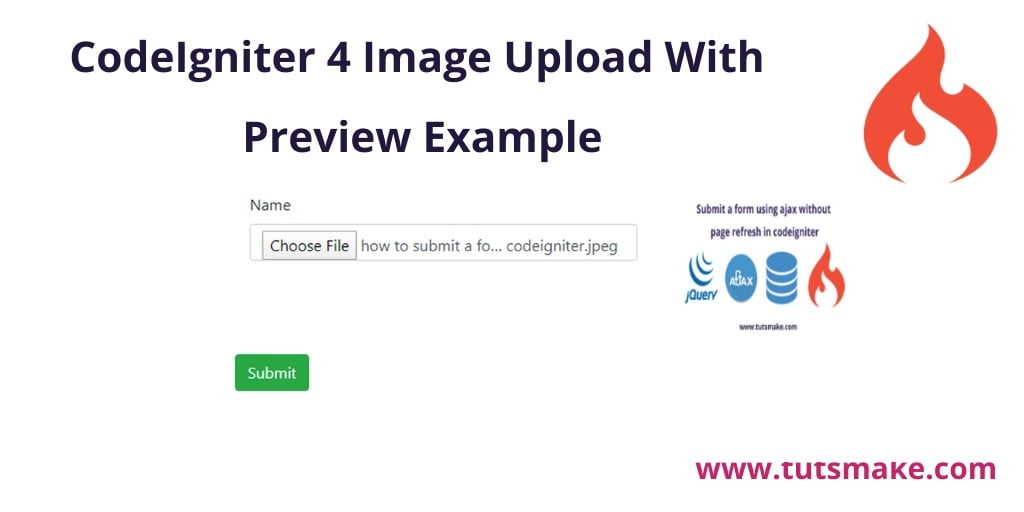To image upload with preview in ci 4; In this tutorial, you will learn how to upload images in Codeigniter 4 apps with preview using jquery.
If you’re looking image that CodeIgniter image upload with a preview, an image upload preview in CodeIgniter 4 with a database example, and save the uploaded image in the database by using CodeIgniter 4, Codeigniter 4 image preview before uploading using jquery demo. So this tutorial is very helpful for you.
Codeigniter 4 jQuery Image Upload with Preview Tutorial
Follow the below steps and easily upload files in folder and store into the database in CodeIgniter 4 projects with preview:
- Step 1: Setup Codeigniter Project
- Step 2: Basic Configurations
- Step 3: Create Database With Table
- Step 4: Setup Database Credentials
- Step 5: Create Controller
- Step 6: Create Views
- Step 7: Start Development server
Step 1: Setup Codeigniter Project
In this step, we will download the latest version of Codeigniter 4, Go to this link https://codeigniter.com/download Download Codeigniter 4 fresh new set up and unzip the setup in your local system xampp/htdocs/ . And change the download folder name to “demo”
Step 2: Basic Configurations
Next, we will set some basic configuration on the app/config/app.php file, so let’s go to application/config/config.php and open this file on the text editor.
Set a Base URL like this
public $baseURL = 'http://localhost:8080'; To public $baseURL = 'http://localhost/demo/';
Step 3: Create Database With Table
In this step, we need to create a database name demo, so let’s open your PHPMyAdmin and create the database with the name demo. After successfully creating a database, you can use the below SQL query for creating a table in your database.
CREATE TABLE files (
id int(11) NOT NULL AUTO_INCREMENT COMMENT 'Primary Key',
name varchar(100) NOT NULL COMMENT 'Name',
type varchar(255) NOT NULL COMMENT 'file type',
created_at varchar(20) NOT NULL COMMENT 'Created date',
PRIMARY KEY (id)
) ENGINE=InnoDB DEFAULT CHARSET=latin1 COMMENT='demo table' AUTO_INCREMENT=1;
Step 4: Setup Database Credentials
In this step, we need to connect our project to the database. we need to go app/Config/Database.php and open the database.php file in a text editor. After opening the file in a text editor, We need to set up database credentials in this file like below.
public $default = [ 'DSN' => '', 'hostname' => 'localhost', 'username' => 'root', 'password' => '', 'database' => 'demo', 'DBDriver' => 'MySQLi', 'DBPrefix' => '', 'pConnect' => false, 'DBDebug' => (ENVIRONMENT !== 'production'), 'cacheOn' => false, 'cacheDir' => '', 'charset' => 'utf8', 'DBCollat' => 'utf8_general_ci', 'swapPre' => '', 'encrypt' => false, 'compress' => false, 'strictOn' => false, 'failover' => [], 'port' => 3306, ];
Step 5: Create Controller
Now Go to app/Controllers and create a controller name Form.php. In this controller, we will create some methods/functions. We will build some of the methods like :
- Index() – This is used to display the file/image upload form.
- Store() – This is used to validate form files/images on the server-side and store in MySQL database and folder.
<?php namespace App\Controllers;
use CodeIgniter\Controller;
class Form extends Controller
{
public function index()
{
return view('form');
}
public function store()
{
helper(['form', 'url']);
$db = \Config\Database::connect();
$builder = $db->table('file');
$validated = $this->validate([
'file' => [
'uploaded[file]',
'mime_in[file,image/jpg,image/jpeg,image/gif,image/png]',
'max_size[file,4096]',
],
]);
$msg = 'Please select a valid file';
if ($validated) {
$avatar = $this->request->getFile('file');
$avatar->move(WRITEPATH . 'uploads');
$data = [
'name' => $avatar->getClientName(),
'type' => $avatar->getClientMimeType()
];
$save = $builder->insert($data);
$msg = 'File has been uploaded';
}
return redirect()->to( base_url('public/index.php/form') )->with('msg', $msg);
}
}
Step 6: Create Views
Now we need to create form.php, go to application/views/ folder and create form.php file. and update the following HTML in your files:
<!DOCTYPE html>
<html>
<head>
<title>Codeigniter 4 Image upload with preview example</title>
<link rel="stylesheet" href="https://stackpath.bootstrapcdn.com/bootstrap/4.3.1/css/bootstrap.min.css">
<script src="https://code.jquery.com/jquery-3.4.1.js"></script>
</head>
<body>
<div class="container">
<br>
<?php if (session('msg')) : ?>
<div class="alert alert-info alert-dismissible">
<?= session('msg') ?>
<button type="button" class="close" data-dismiss="alert"><span>×</span></button>
</div>
<?php endif ?>
<div class="row">
<div class="col-md-9">
<form action="<?php echo base_url('form/store');?>" name="ajax_form" id="ajax_form" method="post" accept-charset="utf-8" enctype="multipart/form-data">
<div class="row">
<div class="form-group col-md-6">
<label for="formGroupExampleInput">Name</label>
<input type="file" name="file" class="form-control" id="file" onchange="readURL(this);" accept=".png, .jpg, .jpeg" />
</div>
<div class="form-group col-md-6">
<img id="blah" src="//www.tutsmake.com/wp-content/uploads/2019/01/no-image-tut.png" class="" width="200" height="150"/>
</div>
<div class="form-group">
<button type="submit" id="send_form" class="btn btn-success">Submit</button>
</div>
</form>
</div>
</div>
</div>
</div>
<script>
function readURL(input, id) {
id = id || '#blah';
if (input.files && input.files[0]) {
var reader = new FileReader();
reader.onload = function (e) {
$(id)
.attr('src', e.target.result)
.width(200)
.height(150);
};
reader.readAsDataURL(input.files[0]);
}
}
</script>
</body>
</html>
This below line display error messages on your web page:
<?php if (session('msg')) : ?>
<div class="alert alert-info alert-dismissible">
<?= session('msg') ?>
<button type="button" class="close" data-dismiss="alert"><span>×</span></button>
</div>
<?php endif ?>
The below script code show preview of your image on your web page:
<script>
function readURL(input, id) {
id = id || '#blah';
if (input.files && input.files[0]) {
var reader = new FileReader();
reader.onload = function (e) {
$(id)
.attr('src', e.target.result)
.width(200)
.height(150);
};
reader.readAsDataURL(input.files[0]);
}
}
</script>
Step 7: Start Development server
To start the development server, Go to the browser and hit below the URL.
http://localhost/demo/public/index.php/form
Conclusion
In this Codeigniter 4 image upload with preview example tutorial. You have learned how to upload images in CodeIgniter 4 projects with preview and how to validate images on the server side in CodeIgniter 4 framework.
Recommended Codeigniter Posts
If you have any questions or thoughts to share, use the comment form below to reach us.
